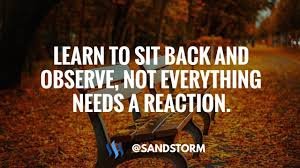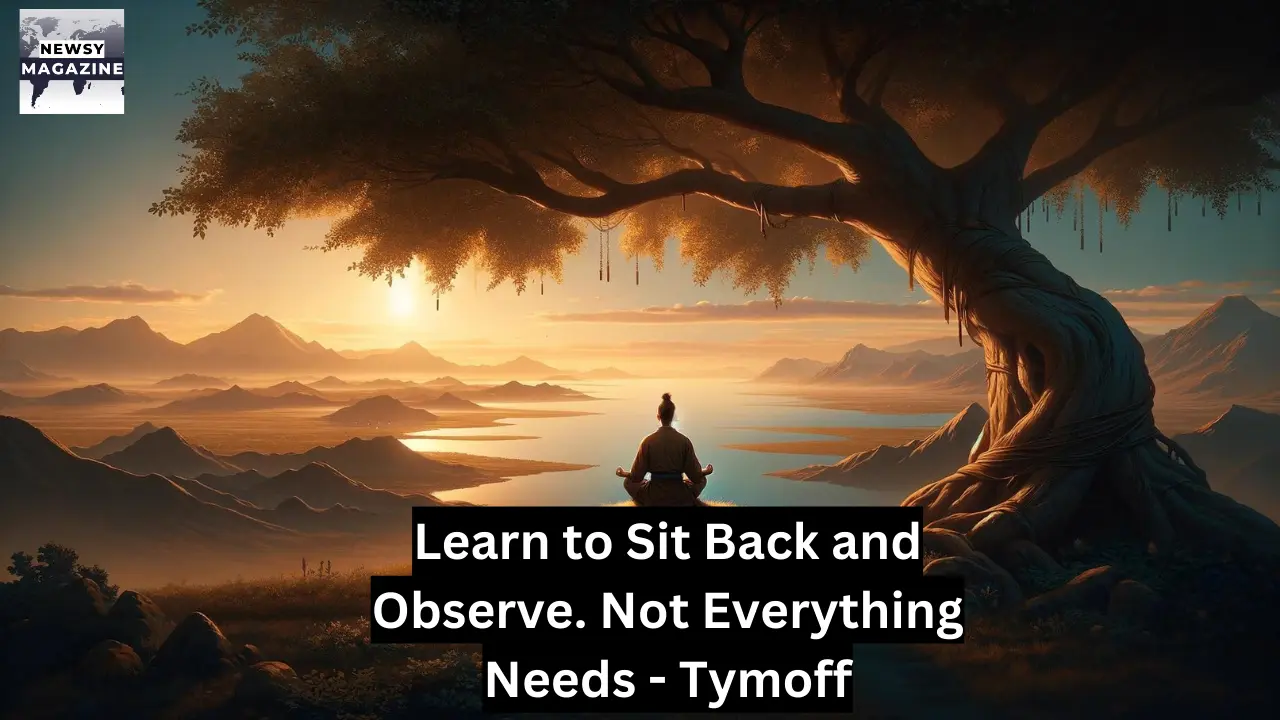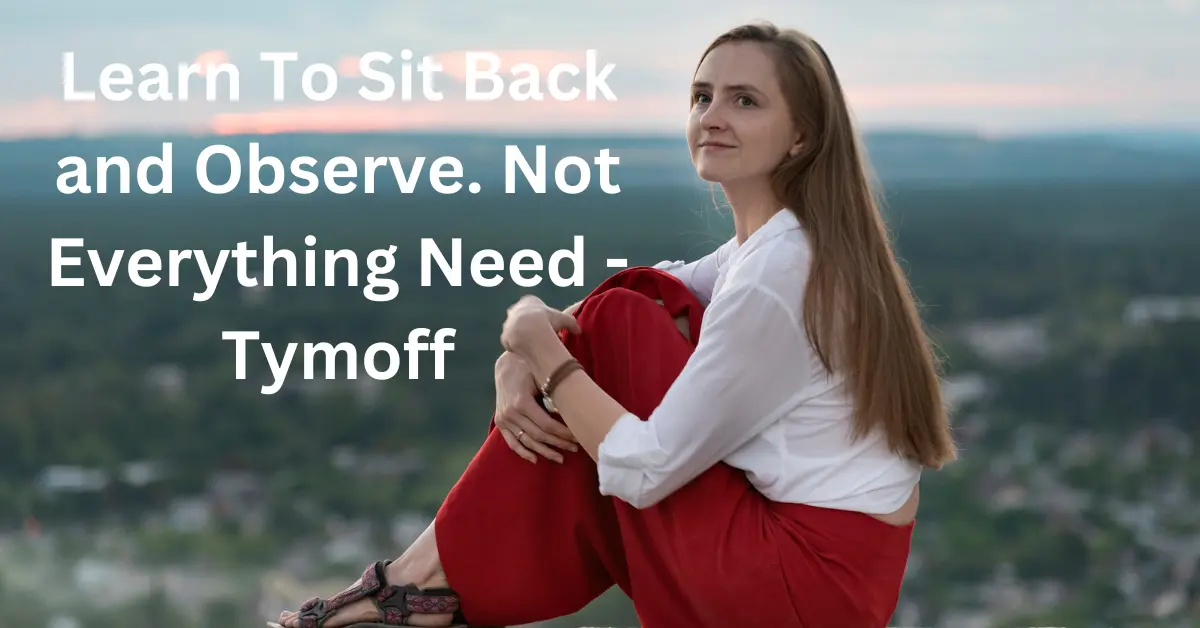Introduction
In a world that thrives on constant hustle and bustle, it’s easy to get swept away in the chaos. We often feel compelled to react immediately, diving headfirst into every situation that arises. But what if we flipped the script? What if instead of rushing to respond, we learned to sit back and observe? The art of observation is not just about watching; it’s about truly understanding our surroundings without jumping to conclusions. This practice can lead us down a path of clarity and insight that many neglects amidst their busy lives. Embracing this mindset—learning to sit back and observe—can unveil opportunities for growth, creativity, and better decision-making. Let’s explore how adopting this perspective can transform your daily interactions and overall well-being.
Learn to sit back and observe. not everything needed – off
In a fast-paced world, we often forget the power of observation. “Learn to sit back and observe. Not everything needs your immediate intervention,” is a valuable lesson from Tymoff that many overlook.
When you step back, you learn to sit back and observe. Not everything needs – tymoff to gain clarity. You see things from different perspectives that might not be evident when you’re too close to the situation.
Observation allows thoughts to marinate. Instead of rushing into decisions, take time to understand the nuances at play. Each detail contributes to a fuller picture.
Moreover, it encourages patience—a rare trait today. By simply watching and absorbing your surroundings or interactions, you cultivate mindfulness.
This approach fosters deeper connections with people and situations alike. It’s about appreciating moments rather than always feeling compelled to react or intervene immediately.
Adopting this mindset can transform how you navigate challenges in life—making space for reflection over reaction can lead to more thoughtful outcomes.
Benefits of Sitting Back and Observing
Sitting back and observing opens up a world of insights. When you take the time to watch rather than act, your awareness expands. You start noticing details that often go overlooked.
This practice sharpens critical thinking skills. By absorbing information without immediate reaction, you can analyze situations more clearly. It encourages deeper understanding.
Moreover, observation leads to better decision-making. With all perspectives in mind, choices become well-informed and thoughtful. You weigh options instead of rushing into conclusions.
In our fast-paced lives, pausing to learn to sit back and observe. Not everything needs – tymoff observation is a rare gift we can give ourselves. It cultivates patience and mindfulness, allowing us to respond authentically rather than react impulsively.
How to Cultivate the Habit of Observation
Cultivating the habit of observation begins with mindfulness. Take a moment each day to pause and engage your senses. Notice the sounds around you, the colors in your environment, and even subtle shifts in mood.
Set aside time for quiet reflection. This can be as simple as sitting in a park or sipping coffee while watching people pass by. Allow yourself to absorb details without rushing.
Journaling can also enhance your observational skills. Write down what you see and feel during these moments of stillness. Over time, this practice sharpens your ability to notice nuances that others might overlook.
Engage with different environments regularly—visit new places, attend events outside your usual routine, or try hobbies that require focused attention. Each experience adds depth to your understanding of the world around you.
Examples of When Observation Is Key
Observation plays a crucial role in various scenarios. For instance, in nature, watching animal behavior can reveal important insights about ecosystems and species interactions.
In the workplace, taking a step back to observe team dynamics can help identify underlying issues that may not be immediately apparent. This perspective often leads to more effective conflict resolution strategies.
When learning a new skill, observing others can accelerate your understanding. Whether it’s cooking or playing an instrument, seeing techniques firsthand provides clarity that reading instructions sometimes lacks.
Even in personal relationships, observation fosters deeper connections. Noticing subtle changes in body language or tone of voice can offer clues about how someone truly feels.
In each case, the act of sitting back and simply observing opens doors to knowledge and awareness that active engagement might overlook.
When to Act and When to Observe
Knowing when to act and when to observe is crucial in both personal and professional contexts. It requires a keen sense of timing, which often comes from experience.
Sometimes, situations demand immediate action. A crisis may unfold that requires your direct involvement. In these moments, hesitation can lead to missed opportunities or worse outcomes.
On the flip side, observation plays a learn to sit back and observe. Not everything needs – tymoff a vital role in understanding complex dynamics. Whether it’s workplace politics or social interactions, taking a step back allows you to gather valuable insights.
Trust your instincts. If something feels off or if you’re unsure about the next steps, pause for a moment of reflection. This space can provide clarity that hurried actions might overlook.
Remember that effective decision-making isn’t just about speed; it’s also about wisdom gained through careful observation and thoughtful consideration.
Conclusion
Taking a step back can reveal layers of understanding often overlooked. When we pause to observe, we gain perspective. This shift in focus allows us to appreciate the subtleties around us.
Embracing observation opens doors to deeper insights and enhances our interactions with others. It strengthens our ability to analyze situations critically, leading to more informed choices.
In a fast-paced world, learning to sit back is an art worth mastering. With practice, it transforms how we experience daily life and challenges.
By allowing ourselves moments of stillness, we invite clarity into our thoughts and actions. The journey of observing becomes just as enriching as that of participating actively in every moment.
Introduction: The Importance of Observing
In our fast-paced world, we often find ourselves rushing from one task to another. We become so consumed by the need to act that we overlook the power of simply observing.
Taking a step back allows us to absorb what’s happening around us. It opens our eyes to details that might otherwise go unnoticed. This practice fosters a deeper understanding of situations and people.
Observation is more than just passive watching; it’s an active engagement with your environment. By being present, you can uncover insights that lead to better decisions and creative solutions.
Learning to sit back and observe enhances your awareness. It encourages mindfulness in everyday life, allowing clarity amidst chaos. With this mindset, even mundane moments can reveal lessons worth learning.
Benefits of Sitting Back and Observing
Taking a moment to sit back and observe can lead to significant benefits in various aspects of life.
One key advantage is increased awareness. By stepping back, you become more attuned to your environment and the subtle dynamics at play. This heightened sense allows for deeper connections with people and situations around you.
Improved critical thinking skills also emerge through observation. When you watch rather than immediately react, you’re able to analyze information more effectively. This practice sharpens your ability to assess complex scenarios without bias.
Better decision-making often follows as well. With a clear perspective gained from observation, choices made are likely informed by insights rather than impulsive reactions. You gain clarity that transforms how you approach challenges.
Embracing the art of watching fosters growth—both personally and professionally—and opens doors to new opportunities for understanding.
A. Increased Awareness

Increased awareness begins with the simple act of sitting back and observing. When we take a moment to pause, we open ourselves up to experiences and details that often go unnoticed in our busy lives. This heightened awareness allows us to connect more deeply with our surroundings.
As you observe, you’ll find patterns and nuances in behaviors, environments, and situations. These insights can lead to a richer understanding of people’s motivations or the dynamics within a group.
When you learn to sit back and observe without rushing to react, your perspective shifts. You start noticing not just what is happening but also why it matters. This clarity helps cultivate empathy toward others while enhancing your self-awareness.
Increased awareness transforms how you engage with the world around you. It empowers better interactions by fostering a space for thoughtful responses rather than impulsive reactions.
B. Improved Critical Thinking Skills
Improved critical thinking learn to sit back and observe. Not everything is needed – tymoff’s skills stem from the ability to observe without immediate reaction. When you take a step back, you create space for deeper analysis.
Observation allows you to gather information that might otherwise be overlooked. This extra data enriches your understanding of situations and people. You learn to identify patterns and connections that inform your judgment.
By observing rather than jumping in, you can weigh different perspectives more effectively. This leads to well-rounded conclusions instead of hasty decisions based on minimal insight.
Moreover, practicing observation fosters an open mindset. You’re less likely to cling rigidly to preconceived notions when you’re focused on what’s happening around you.
As a result, your problem-solving abilities strengthen over time. The more adept you become at noticing nuances in everyday life, the sharper your critical thinking skills will grow.
C. Better Decision Making
Sitting back and observing can profoundly influence decision-making. By taking a moment to step away, you create space for clarity.
When you observe rather than react, you gather valuable insights. This process allows you to see situations from multiple angles, revealing nuances that might otherwise go unnoticed.
You start recognizing patterns and understanding dynamics at play. With this knowledge in hand, your choices become more informed.
Rather than rushing into decisions based on impulse or emotion, observation encourages patience. It invites deliberation over hasty conclusions.
As a result, your decisions are not only better informed but also aligned with your values and goals. This thoughtful approach minimizes regrets and enhances confidence in the outcomes you choose.
Detrimental Effects of Not Observing
When we rush through life, neglecting to observe, we miss out on invaluable insights. This hurried mindset can cloud our judgment and lead to poor decisions.
Failing to notice subtle cues in our environment may result in misunderstandings or missed opportunities. Relationships often suffer; without observation, communication becomes one-sided and superficial.
Additionally, a lack of awareness can hinder personal growth. We might overlook patterns in our behavior that need addressing or fail to recognize moments for self-reflection.
In the workplace, not observing can stifle creativity and innovation. Ideas flourish when we take the time to absorb what’s around us. Instead of thriving on collaboration and inspiration, we risk stagnation.
Living mindlessly limits experiences and reduces overall satisfaction with life. By neglecting observation, we inadvertently choose ignorance over insight.
Tips for Developing Observation Skills

To sharpen your observation skills, start by practicing mindfulness. Spend a few minutes each day focusing on your surroundings. Notice the sounds, colors, and movements around you.
Engage your senses fully. Instead of just seeing a park, feel the texture of leaves or breathe in the fresh air. This deepens your awareness and enhances what you observe.
Keep a journal to record interesting observations. Write about moments that catch your attention—details you might usually overlook.
Limit distractions in your daily life. Put away devices when possible and immerse yourself in the present moment.
Try observing people without judgment or preconceived notions. Pay attention to body language and expressions; this will help build empathy as well as observational acumen.
Be curious! Ask questions about what you see and hear; curiosity fuels deeper understanding and engagement with the world around you.
How to Incorporate Observation into Daily Life
Incorporating observation into daily life can be refreshing and enlightening. Start by intentionally setting aside time to just watch your surroundings. Whether you’re in a café or walking in the park, take a moment to absorb what’s happening around you.
Engage all your senses; notice the sounds, colors, and even scents. This practice helps ground you in the present moment while sharpening your awareness.
Keep a journal handy. Jot down things that catch your attention—a conversation snippet, an intriguing facial expression, or nature’s details. Writing enhances retention and deepens understanding.
Make it a habit to ask questions about what you observe. Why is someone behaving that way? What led to this situation? This curiosity fuels critical thinking and enriches experiences.
Limit distractions during moments of observation. Put away phones or other devices so you can truly connect with the world around you without interruptions.
Learn to sit back and observe. not everything needed – off
In our fast-paced world, we often rush to respond. We feel the pressure to act immediately, but there’s immense power in taking a step back. When you learn to sit back and observe, you create space for clarity.
This isn’t about being passive; it’s about engaging your mind differently. Observation allows you to gather context that can transform reactions into informed decisions.
Imagine watching a complex situation unfold without jumping in right away. You begin to notice patterns and motives that would otherwise go unseen. This insight can lead to more meaningful interactions.
By embracing learning to sit back and observe. Not everything needs – off this approach, you’re not just reacting; you’re understanding the bigger picture. It encourages patience and fosters deeper connections with people around you and within yourself.
Conclusion: The Value of Taking a Step Back and Observing
Taking a step back and observing can unlock new perspectives in our daily lives. When we allow ourselves to pause, we create space for clarity. This practice fosters increased awareness and sharpens our critical thinking skills.
By embracing observation, we learn to sit back and observe. Not everything needed – off the ability to make informed decisions rather than impulsive ones. It’s essential to remember that not every situation requires immediate action; sometimes, simply watching is enough.
As you integrate this habit into your life, you’ll discover its transformative power. Observation can lead us down paths of creativity and understanding that rushed actions often overlook. Cultivating this skill enhances not just personal growth but also improves interactions with others.
Sitting back does not equate to inactivity—it’s an active choice that brings depth to our experiences. The next time you’re faced with a challenging situation or decision, consider taking the time to observe first. You may find insights waiting just beneath the surface, ready for you to uncover them through patient reflection and thoughtful consideration.




